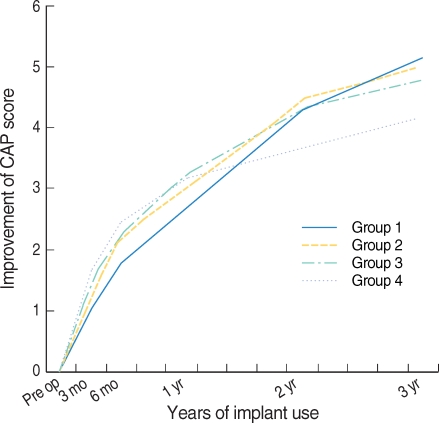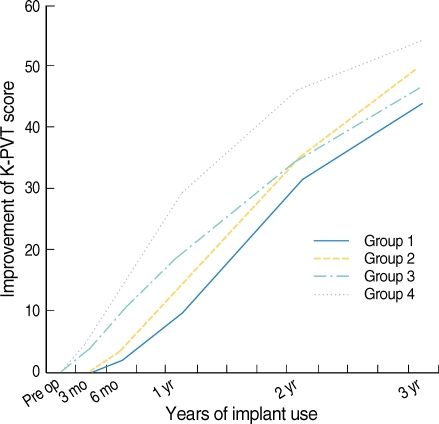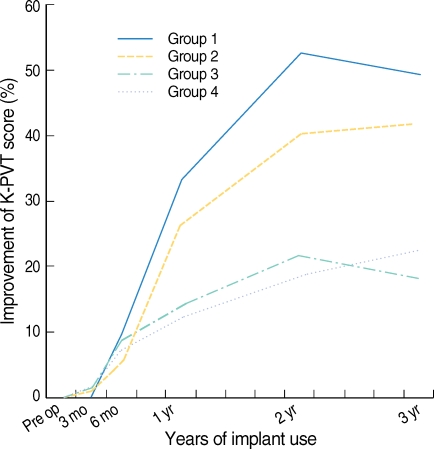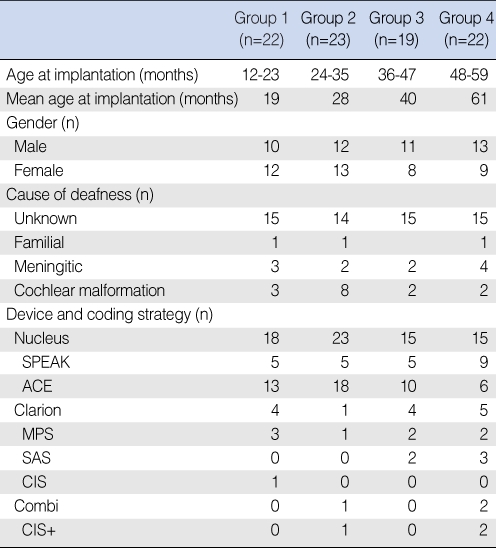1. Cho EK, Park HY, Kim JW, Hah JH, Kim CS. Factors influencing speech perception abilities in cochlear-implanted children. Adv Otorhinolaryngol. 2000; 57:145–147. PMID:
11892130.

2. Baumgartner WD, Pok SM, Egelierler B, Franz P, Gstoettner W, Hamzavi J. The role of age in pediatric cochlear implantation. Int J Pediatr Otorhinolaryngol. 2002; 2. 62(3):223–228. PMID:
11852125.

3. Cheng AK, Grant GD, Niparko JK. Meta-analysis of pediatric cochlear implant literature. Ann Otol Rhinol Laryngol Suppl. 1999; 4. 177:124–128. PMID:
10214816.
4. Geers AE. Speech, language, and reading skills after early cochlear implantation. Arch Otolaryngol Head Neck Surg. 2004; 5. 130(5):634–638. PMID:
15148189.

5. Kileny PR, Zwolan TA, Ashbaugh C. The influence of age at implantation on performance with a cochlear implant in children. Otol Neurotol. 2001; 1. 22(1):42–46. PMID:
11314714.
6. Manrique M, Cervera-Paz FJ, Huarte A, Molina M. Advantages of cochlear implantation in prelingual deaf children before 2 years of age when compared with later implantation. Laryngoscope. 2004; 8. 114(8):1462–1469. PMID:
15280727.

7. Zwolan TA, Ashbaugh CM, Alarfaj A, Kileny PR, Arts HA, El-Kashlan HK, et al. Pediatric cochlear implant patient performance as a function of age at implantation. Otol Neurotol. 2004; 3. 25(2):112–120. PMID:
15021769.

8. Lee DS, Lee JS, Oh SH, Kim SK, Kim JW, Chung JK, et al. Cross-modal plasticity and cochlear implants. Nature. 2001; 1. 409(6817):149–150. PMID:
11196628.

9. Oh SH, Kim CS, Kang EJ, Lee DS, Lee HJ, Chang SO, et al. Speech perception after cochlear implantation over a 4-year time period. Acta Otolaryngol. 2003; 1. 123(2):148–153. PMID:
12701730.

10. Fryauf-Bertschy H, Tyler RS, Kelsay DM, Gantz BJ, Woodworth GG. Cochlear implant use by prelingually deafened children: the influences of age at implant and length of device use. J Speech Lang Hear Res. 1997; 2. 40(1):183–199. PMID:
9113869.
11. Papsin BC, Gysin C, Picton N, Nedzelski J, Harrison RV. Speech perception outcome measures in prelingually deaf children up to four years after cochlear implantation. Ann Otol Rhinol Laryngol Suppl. 2000; 12. 185:38–42. PMID:
11140997.

12. Kirk KI, Miyamoto RT, Lento CL, Ying E, O'Neill T, Fears B. Effects of age at implantation in young children. Ann Otol Rhinol Laryngol Suppl. 2002; 5. 189:69–73. PMID:
12018353.

13. Miyamoto RT, Kirk KI, Svirsky MA, Sehgal ST. Communication skills in pediatric cochlear implant recipients. Acta Otolaryngol. 1999; 3. 119(2):219–224. PMID:
10320080.
14. Papsin BC. Cochlear implantation in children with anomalous cochleovestibular anatomy. Laryngoscope. 2005; 1. 115(1 Pt 2):Suppl 106. 1–26. PMID:
15626926.

15. Archbold S, Lutman ME, Marshall DH. Categories of auditory performance. Ann Otol Rhinol Laryngol Suppl. 1995; 9. 166:312–314. PMID:
7668685.
16. Archbold S, Lutman ME, Nikolopoulos T. Categories of auditory performance: inter-user reliability. Br J Audiol. 1998; 2. 32(1):7–12. PMID:
9643302.

17. Kim YT, Chang HS, Im SS, Baek HJ. Picture vocabulary test. 1995. Seoul: Seoul Community Rebabilitation Center.
18. Dunn LM, Dunn DM. Peabody picture vocabulary test-revised. 1981. Circle Pines, MN: American Guidance Service.
19. Govaerts PJ, De Beukelaer C, Daemers K, De Ceulaer G, Yperman M, Somers T, et al. Outcome of cochlear implantation at different ages from 0 to 6 years. Otol Neurotol. 2002; 11. 23(6):885–890. PMID:
12438851.

20. Lenarz T, Lesinski-Schiedat A, von der Haar-Heise S, Illg A, Bertram B, Battmer RD. Cochlear implantation in children under the age of two: the MHH experience with the CLARION cochlear implant. Medizinische Hochschule Hannover. Ann Otol Rhinol Laryngol Suppl. 1999; 4. 177:44–49. PMID:
10214801.
21. Serry TA, Blamey PJ. A 4-year investigation into phonetic inventory development in young cochlear implant users. J Speech Lang Hear Res. 1999; 2. 42(1):141–154. PMID:
10025550.

22. Waltzman SB, Cohen NL. Cochlear implantation in children younger than 2 years old. Am J Otol. 1998; 3. 19(2):158–162. PMID:
9520051.




 PDF
PDF Citation
Citation Print
Print






 XML Download
XML Download